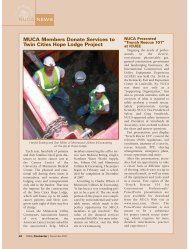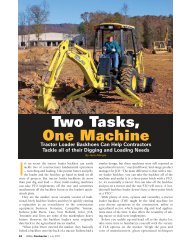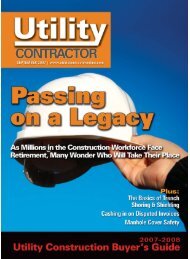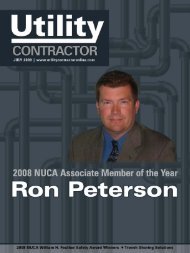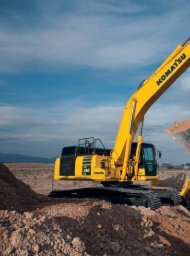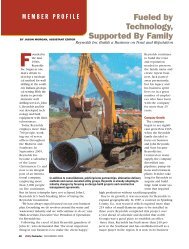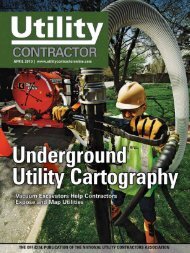View Full December PDF Issue - Utility Contractor Online
View Full December PDF Issue - Utility Contractor Online
View Full December PDF Issue - Utility Contractor Online
Create successful ePaper yourself
Turn your PDF publications into a flip-book with our unique Google optimized e-Paper software.
Stabilization legs also help operators get the most<br />
maneuverability out of light towers because the added<br />
support allows masts to be extended horizontally to shine<br />
light on the underside of bridges, for example.<br />
Power Hours<br />
Fuel efficiencies and run times are also important features<br />
for utility contractors who depend on light towers when<br />
working on tight deadlines, especially given that the machines<br />
must be allowed to cool before they may be refueled safely.<br />
Walsh, who says paying attention to fuel capacities when<br />
choosing a light tower can help contractors save minutes,<br />
even hours, as they don’t have to stop as often to refuel, also<br />
noted that a full 30-gal tank of fuel should power about 60<br />
to 70 hours of operation time between refills.<br />
Output power is another common area that contractors tend<br />
to gloss over when picking out a light tower. A standard 60-Hz<br />
light tower with a 20-amp duplex outlet, for instance, can be<br />
used to conveniently power small power tools. Yet Walsh says<br />
Chicago Pneumatic offers power sockets as an option on its<br />
120-V light towers because some contractors prefer to avoid<br />
the headaches associated with overusing the outlets.<br />
“Operators will sometimes run each of those outlets to a<br />
drop cord and plug six things into it, including additional<br />
drop cords,” Walsh says. “They end up blowing a fuse or<br />
blowing a circuit. Some customers prefer light towers<br />
without sockets in order to minimize that risk.”<br />
Got a Light?<br />
When water mains burst, gas lines leak or electrical<br />
power goes out, utility contractors typically don’t have<br />
the luxury of waiting until the sun rises to address those<br />
issues along public right-of-ways. In addition to procuring<br />
reliable machines to power through non-daylight hours, it is<br />
important for contractors to know where to find light towers<br />
on short notice from sources such as local rental stores or<br />
equipment dealers.<br />
“Their immediate concern is how quickly they can get<br />
one,” says Walsh, adding that contractors are not typically<br />
given a month’s advance warning when they<br />
need a light tower to successfully complete<br />
time-sensitive projects. Faced with closing<br />
bridges, roads or highways for extended<br />
periods of time, and potentially disrupting<br />
pedestrian and vehicular traffic patterns<br />
along major thoroughfares, governments<br />
and municipalities have been known<br />
to offer financial incentives, such<br />
as bonuses, to contractors who<br />
can restore utilities ahead of<br />
schedule.<br />
“These types of projects are<br />
typically done at night, and light<br />
towers allow crews to work straight<br />
through the night,” Walsh says. He says<br />
that other than having a handle on where<br />
to obtain light towers in a timely manner, it<br />
is important for operators to understand how to utilize the<br />
machines to their fullest potential.<br />
Right Lights<br />
Equipment failure is a dim prospect for utility contractors<br />
who rely on dependable sources of light to brighten roads,<br />
highways, bridges, trenches and other jobsites. <strong>Contractor</strong>s<br />
looking for the most reliable sources of electric-powered<br />
illumination must also think about how quickly and easily<br />
it may be to pick up replacement parts in the event of a<br />
malfunction.<br />
In addition to avoiding knock-off brand engines and<br />
alternators, for which parts may be more difficult to acquire<br />
on the fly, contractors should consider how the potential<br />
inability to obtain parts in a hurry could affect the cost to<br />
rent or own light towers.<br />
“Generic engines and alternators may present an<br />
attractive option to contractors trying to save money on<br />
the front end,” Walsh says. “But if those less well-known<br />
machines falter, leaving work crews in the dark until<br />
repairs can be made, then the overall cost of ownership<br />
tends to increase dramatically.”<br />
In addition to performing regularly scheduled oil and<br />
filter changes, which helps to increase the lifespan of light<br />
tower engines, would-be owners should think about buying<br />
light towers that feature wide service doors and electrical<br />
cubicles, both of which allow for easy maintenance.<br />
“Those tasks shouldn’t be overlooked,” Walsh says of<br />
preventive maintenance. He says the majority of rental<br />
companies tend to deal with both the preventive maintenance<br />
and mechanical issues on the equipment they offer. Suppliers<br />
usually take care of the rest, he says. “Regardless of which<br />
brand of light tower that contractors choose, taking the time to<br />
consider the overall performance, portability and functionality<br />
of light sources will pay off at the end of the day,” Walsh says.<br />
Todd Razor is a technical writer for Performance Marketing, based<br />
in Des Moines, Iowa.<br />
The Illumination Engineering Society (IES) is the organization that sets the<br />
standards for determining safe and proper levels of illumination. The IES<br />
requires that a general construction site have at least 10 footcandles of<br />
illumination, while 1 to 5 footcandles are sufficient for a parking area.<br />
<strong>December</strong> 2011 | <strong>Utility</strong> <strong>Contractor</strong> 27




